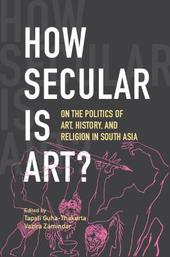
|
How Secular Is Art?: On the Politics of Art, History and Religion in South Asia
Paperback / softback
Main Details
| Title |
How Secular Is Art?: On the Politics of Art, History and Religion in South Asia
|
| Authors and Contributors |
Edited by Tapati Guha-Thakurta
|
|
Edited by Vazira Zamindar
|
| Physical Properties |
| Format:Paperback / softback |
|
| Category/Genre | Art treatments and subjects
Religious subjects depicted in art |
|---|
| ISBN/Barcode |
9781009380478
|
| Classifications | Dewey:709.54 |
|---|
| Audience | |
|---|
| Illustrations |
Worked examples or Exercises
|
|
Publishing Details |
| Publisher |
Cambridge University Press
|
| Imprint |
Cambridge University Press
|
| NZ Release Date |
30 June 2023 |
| Publication Country |
United Kingdom
|
Description
As an invitation to interrogate the secular modality of art, the book unsettles both the categories of 'art' and 'secular' in their theoretical and historical implications. It questions the temporal, spatial and cultural binaries between the 'sacred' and the 'secular' that have shaped art historical scholarship as well as artistic practice. All the essays here are anchored in a conception of a region, whether we call it South Asia or the Indian subcontinent - one, fissured by histories of partition, state formations and religious nationalisms, but still offering a collective site from which to speak to the disciplines of art and the knowledge worlds in which they are embedded. The book asks: How do we complicate the religious designations of pre-modern art and architecture and the new forms of their resurgence in contemporary iconographies and monuments? How do we re-conceptualize the public and the political, as fiery contestations and new curatorial practices reconfigure the meaning of art in the proliferating spaces of museums, galleries, biennales and festivals? How do we understand South Asian art's deep entanglements with the politics of the present?
Author Biography
Tapati Guha-Thakurta was Professor in History at the Centre for Studies in Social Sciences, Calcutta, which she directed from 2012 to 2017. Her work is located within the disciplinary fields of cultural history, history of art and visual studies. She has written widely and taught courses on the themes of art, nationalism and modernity, art history and archaeology, the careers of monuments and museum objects, and popular urban visual culture of modern and contemporary India. Three of her most prominent works are The Making of a New 'Indian' Art: Artists, Aesthetics and Nationalism in Bengal (Cambridge University Press, 1992), Monuments, Objects, Histories: Institutions of Art in Colonial and Postcolonial India (Columbia University Press, and Permanent Black, 2004), and In the Name of the Goddess: The Durga Pujas of Contemporary Kolkata (Primus Books, 2015). Vazira Zamindar is Associate Professor of history at Brown University, Rhode Island, and works on decolonization, displacement, war, nonviolence, the visual archive and contemporary art. She is the author of The Long Partition and the Making of Modern South Asia: Refugees, Boundaries, Histories (Columbia University Press, 2007), and co-editor of Love, War and Other Longings: Essays on Cinema in Pakistan (Oxford University Press, 2020). She initiated the interdisciplinary discussion forum Art History from the South (2018-20), co-organized the symposiums How Secular is Art? (Fall 2018) and Art History, Postcolonialism and the Global Turn (Fall 2020), and collaborates with the Decolonial Initiative on Migration of Objects and People. She is presently working on a monograph on archaeology, art history, photography, film and war on the Indo-Afghan borderlands, and a graphic novel with Sarnath Banerjee on Gandhi and Abdul Ghaffar Khan.
Reviews'Abandoning conventional analyses of secularism, dominated as they are by the language of law and politics, this superb volume of essays focusses instead on the practices and representations through which it is both manifested and debated in everyday life. In doing so it offers a fresh new approach to the secular as both idea and reality.' Faisal Devji, University of Oxford 'The question mark that hangs from the title of this volume, How Secular Is Art? summons the unsettled field of contestation surrounding secularism in South Asia that continues to torment the region. Bringing together interdisciplinary and cross-border perspectives and engaging with phenomena across the visual field-from festivals, exhibitions, monuments, and architecture to painting, art criticism, and contemporary art-this excellent collection of essays probes the profound ways that the crisis of secularism in South Asia has been uniquely played out in the realm of art and visual culture. It is a passionate, urgent, and timely intervention that raises many crucial questions for the future.' Saloni Mathur, University of California, Los Angeles 'The essays in this volume refresh our conceptions about political and religious art and their mutual relationships in exciting ways. Coming from diverse disciplinary affiliations, they look at iconic and street art, old and new monuments, secular and sectarian visual forms. As they suggest interconnections among several South Asian contexts, and their experiences of the visual and the political, they also enlarge our conceptual understandings of art and politics, faith, and protest. Above all, the essays, in their different ways, add significant new dimensions to long-standing debates and discourses about secularism and secularization. They explore secular-democratic movements against religious intolerance which, nonetheless, are represented within the visual signs and frames of sectarian piety and religious self-designation. By asking what such entanglement means for the various interpretations of secularism, they reconfigure our understanding of the cultural and political histories of contemporary South Asia.' Tanika Sarkar, Jawaharlal Nehru University, New Delhi
|